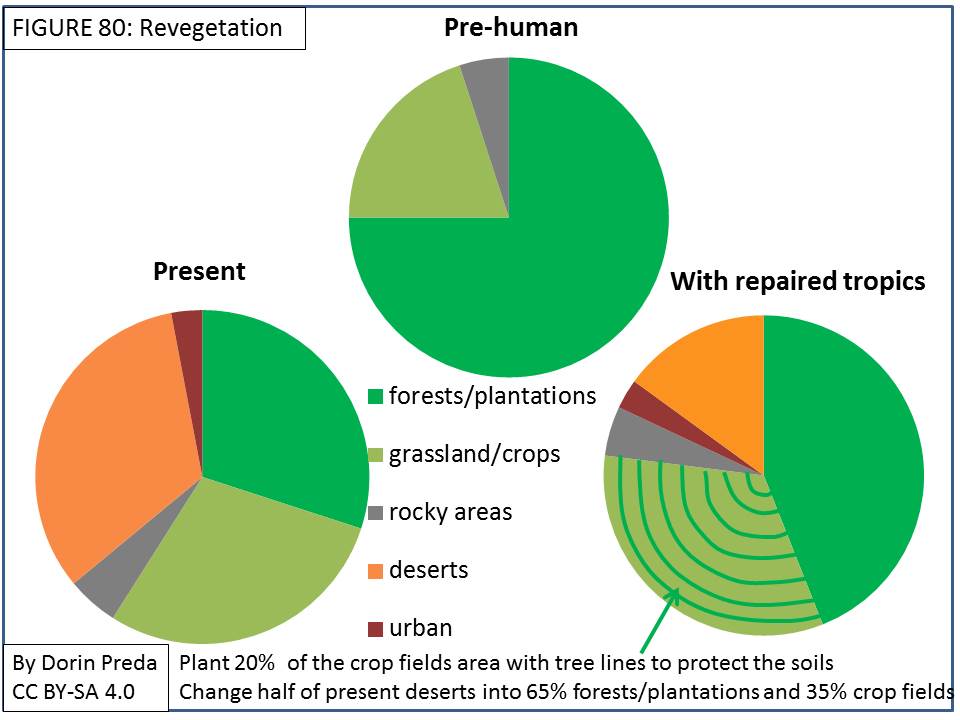
RESTORING CLIMATE A breakthrough and a must read for anybody interested in climate change
This 2019 – 2024 study and book are based on my expertise in coastal processes, meteorology-hydrology, heat transfer and solar energy. It demonstrates how deforestation from prehistoric times to the present has destabilized the global water cycle, leading to fires, floods, desertification and climate change.
The ideas in this book were used in 2025 in an initiative for a Consolidated Climate Change Theory to promote international cooperation for climate restoration.
Deforestation warming is shown to be larger than carbon gases warming, thus the climate can be restored by planting trees in a new way, by combining useful trees and especially fruit trees with replanted forests; they also capture atmospheric carbon dioxide as an added bonus.
This study explains the relationship between deforestation and climate change, briefly calculates the magnitude of those changes, and suggests highly beneficial methods of climate restoration. The book offers detailed explanations and easy-to-follow calculations.
To receive the next day a copy of the eBook (290 pages and 100 figures and diagrams), simply include your email address in the “Add a note” section when submitting $10 through PayPal. You will also receive a receipt for your purchase. For the paperback version visit: Barnes & Noble or Amazon.

For about 1.5 million years humans have used fire and later mechanical means to clear almost all former forests for hunting, pastoralism or agriculture. The intertropical areas that were first inhabited receive large solar radiation, so the deforested soils were quickly destroyed by heat and erosion. That overheated ground dries out the atmosphere above it and any humid wind coming from the ocean, so no rain can form above today`s tropical deserts.
All that humidity, which previously produced rain on the former tropical and equatorial forests and created their rivers, cannot now discharge in those deserts, so it can only condense in the further colder areas. Those higher latitude areas are now overheated by the heat coming as humidity from the tropical oceans, while the rare but excessive precipitation creates floods. We can stop this imbalance by re-vegetating the intertropical areas to attract again the rain from the intertropical ocean, while also sequestering atmospheric carbon into trees.

The decrease in evaporation due to vegetation clearing results in solar overheating of the ground and of the air (the source of global warming), which is subsequently amplified through the greenhouse effect.
Conceptual simulations and reality checks allow understanding the role of water and how to use it to restore regional climate.
It is explained why building in forest clearings leads to very intense forest fires, and there are shown safer solutions for living surrounded by trees.
New heat transfer analyses and realistic quantitative estimations increase confidence in our ability of restoring the regional and global climates by re-balancing the regional and global water cycle.
Albedo should only be used when considering all relevant parameters, otherwise it would appear that vegetation and water warm the Earth, while this study demonstrates that they are the most powerful coolers.

It is shown how water produces stronger cooling than its greenhouse effect. Trees have the greatest capacity to extract and evaporate water.
The first requirement is to stop net deforestation and forest fires, thus soil erosion and the increase of atmospheric carbon dioxide.
The second step is to start revegetation of intertropical areas to sequester carbon and re-balance the climate. Revegetation of the Middle East and North Africa will cool and stop floods in Europe, will decrease the overheating of the Arctic and might decrease Atlantic hurricanes.
Australia has a great capacity to recover from its artificial state of “the driest continent” because the surrounding oceans send humid winds above it. Through the proper revegetation method described in the book we can increase precipitation and transform Australia back into a bio-diverse, but also highly agriculturally productive and beautiful continent.
Restructuring agriculture can restore regional climate through increased evapotranspiration, while also increasing many fold the income and food production per hectare. Soils can be repaired, carbon emissions reduced, while existing atmospheric carbon would automatically be sequestered.
A new urban architecture style is the unitary rational building (URB), a very compact city that provides for all requirements of a civilized, modern lifestyle, even in a natural or rural setting. The URB has by far the lowest capital, running and transportation costs, while allowing green land uses around it.
If Amazonia and Central Africa are revegetated with these methods, ocean evaporated water will reinstate the large intertropical precipitation regime. Repairing the water cycle will stop present devastating droughts, forest fires and floods, restore regional climates and improve the global one.
The book describes customized solutions for: Maroc, Algeria, Tunisia, Libya, Egypt, Central Africa, USA, Australia, South America, Indonesia, and Somalia. The global climate would re-balance if North Africa and Australia would be revegetated for the benefit of both hemispheres. Australia especially has an Outstanding Climate and Business Opportunity.
The book is a collection of breakthroughs in climate understanding, agriculture, applied climate restoration, nature conservation, land management, transportation, urban planning and architecture. It provides achievable solutions for improving the climate, economy and general wellbeing of people.
To receive a copy of the eBook the next day, simply include your email address in the “Add a note” section when submitting $10 through PayPal. For the paperback version visit: Barnes & Noble or Amazon. Copyright 2020 Dorin Preda
There are great initiatives of groups like Water Stories which started to implement water cycle restoration in many places around the world.
The movie below is a testimony to the talent, generosity and dedication of Zach’s group to Earth’s restoration.
